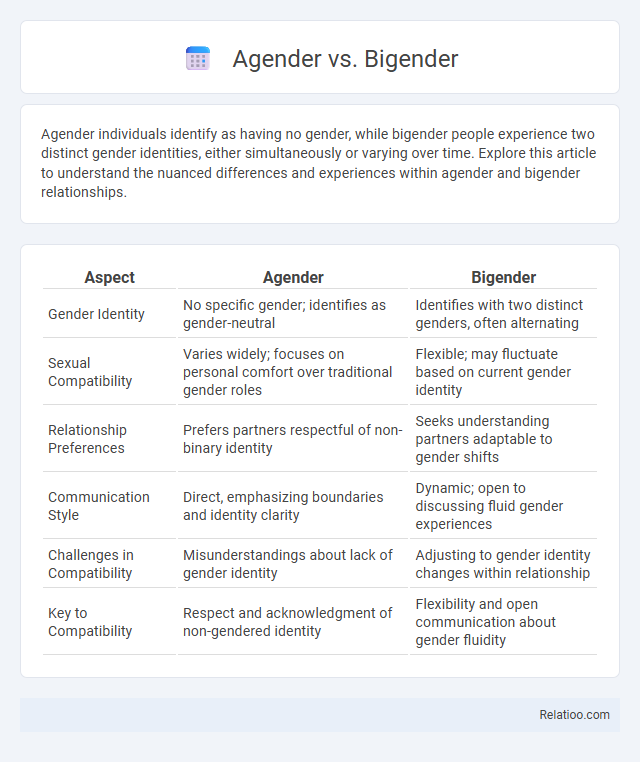Agender individuals identify as having no gender, while bigender people experience two distinct gender identities, either simultaneously or varying over time. Explore this article to understand the nuanced differences and experiences within agender and bigender relationships.
Table of Comparison
| Aspect | Agender | Bigender |
|---|---|---|
| Gender Identity | No specific gender; identifies as gender-neutral | Identifies with two distinct genders, often alternating |
| Sexual Compatibility | Varies widely; focuses on personal comfort over traditional gender roles | Flexible; may fluctuate based on current gender identity |
| Relationship Preferences | Prefers partners respectful of non-binary identity | Seeks understanding partners adaptable to gender shifts |
| Communication Style | Direct, emphasizing boundaries and identity clarity | Dynamic; open to discussing fluid gender experiences |
| Challenges in Compatibility | Misunderstandings about lack of gender identity | Adjusting to gender identity changes within relationship |
| Key to Compatibility | Respect and acknowledgment of non-gendered identity | Flexibility and open communication about gender fluidity |
Understanding Gender Identity: Agender vs Bigender
Understanding gender identity involves recognizing how individuals experience their own gender. Agender refers to a person who identifies as having no gender or a neutral gender, while Bigender describes someone who identifies with two distinct genders, either simultaneously or varying between them. Your exploration of these identities highlights the diverse spectrum of human gender experiences and the importance of respecting each individual's self-identification.
Defining Agender: Meaning and Key Traits
Agender refers to a gender identity characterized by the absence of any gender, often described as being gender-neutral or genderless. Key traits of agender individuals include a lack of identification with traditional male or female roles and a preference for neutral pronouns such as they/them. Unlike bigender identities, where individuals experience two gender identities simultaneously or fluctuate between them, agender people experience a singular, non-binary gender identity that transcends the gender spectrum.
What It Means to Be Bigender
Bigender individuals experience two distinct gender identities, either simultaneously or fluctuating between them, which can include a combination of male, female, or other gender identities. This contrasts with agender people who identify as having no gender and those exploring broader gender identities beyond the binary. Understanding your gender identity involves recognizing the unique ways bigender people navigate and express their dual experiences within personal and social contexts.
Differences Between Agender and Bigender
Agender individuals identify as having no gender, often experiencing a neutral or absent gender identity, while bigender people identify with two distinct genders, either simultaneously or varying over time. The key difference lies in agender's absence of gender versus bigender's dual or fluid gender experiences. Gender identity encompasses the broad spectrum of personal identification with gender, including agender, bigender, and many other identities.
Common Misconceptions About Agender and Bigender
Agender and bigender identities are often misunderstood, with common misconceptions including the false belief that agender individuals lack any gender identity or that bigender people are simply confused. Your understanding benefits from recognizing agender as a non-binary identity characterized by the absence of gender, while bigender individuals experience two distinct gender identities either simultaneously or fluidly. Both identities challenge traditional binary notions of gender, emphasizing the diversity and complexity of gender identity beyond conventional categories.
Social Challenges Faced by Agender and Bigender Individuals
Agender and bigender individuals often confront unique social challenges stemming from societal misunderstandings and rigid gender norms. You may experience misgendering, lack of recognition, and exclusion in various social settings, which can impact mental health and self-esteem. Awareness and inclusive practices are essential to support the diverse experiences within the spectrum of gender identity.
Representation of Agender and Bigender Identities in Media
Media representation of agender and bigender identities remains limited but is gradually increasing as awareness of diverse gender identities grows. Agender portrayals often emphasize a lack of gender or gender neutrality, while bigender characters are depicted as embodying two distinct gender identities, challenging traditional binary norms. Increased visibility in shows like "Transparent" and web series such as "Gender Defied" helps normalize these identities, fostering broader acceptance and understanding.
Navigating Pronouns and Communication
Navigating pronouns and communication can be complex for individuals identifying as agender or bigender, as agender people often prefer gender-neutral pronouns like they/them, while bigender individuals may alternate pronouns depending on their gender expression at a given time. Understanding your unique gender identity allows you to communicate your pronouns clearly to others, fostering respect and inclusivity in conversations. Emphasizing open dialogue and asking for preferred pronouns ensures that you honor each person's self-identified experience, enhancing mutual understanding and support.
Supporting Agender and Bigender People
Supporting agender and bigender people involves understanding the distinctions within gender identity, where agender individuals identify as having no gender, while bigender people experience two gender identities simultaneously or varying between them. Creating inclusive environments requires using correct pronouns, respecting self-identification, and offering affirming resources that validate their unique experiences. Your commitment to education and empathy fosters acceptance and mental well-being for agender and bigender communities.
The Importance of Inclusive Language and Spaces
Understanding agender, bigender, and other gender identities highlights the critical importance of inclusive language and spaces in fostering respect and validation. Your use of affirming terms and creating environments that honor diverse gender experiences can significantly improve mental health and social acceptance for non-binary individuals. Inclusive practices promote visibility and equality, ensuring all identities are acknowledged and supported.

Infographic: Agender vs Bigender
 relatioo.com
relatioo.com